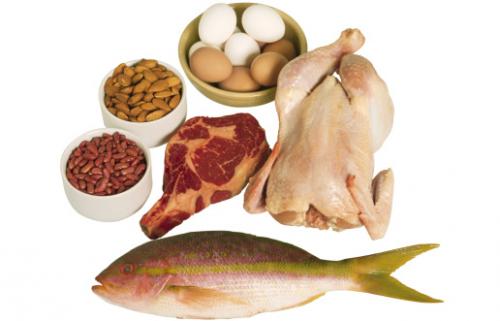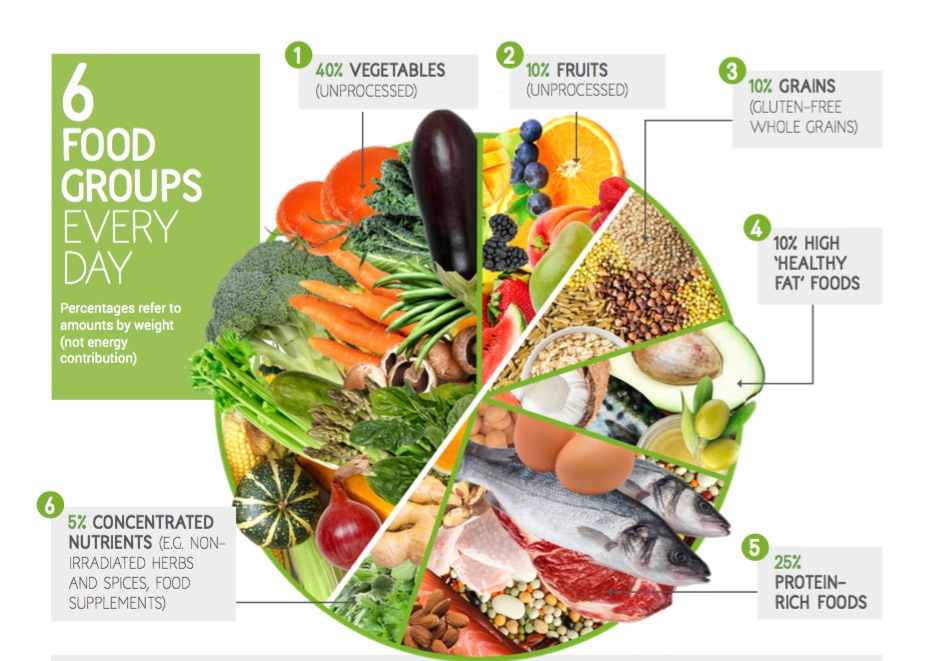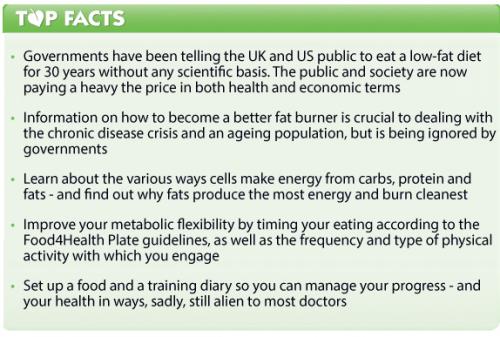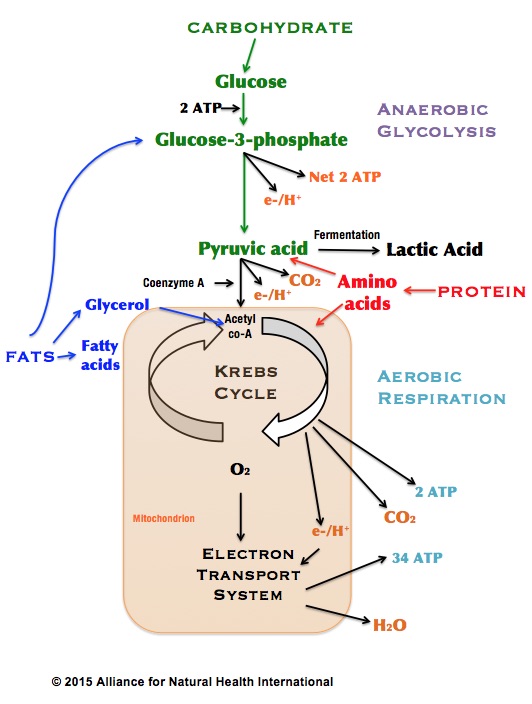Content Sections
- ● How do you burn your fuel?
- ● Anaerobic glycolysis of each glucose molecule yields just two ATP molecules
- ● Aerobic glycolysis of each glucose molecule yields an additional 34 ATP molecules
- ● Oxidation of proteins and fats
- ● Nutritional ketosis
- ● Getting flexible nutritionally and physically
- ● Transitioning from being a carb burner to a fat burner
- ● Planning for health
By Rob Verkerk PhD
Founder, executive and scientific director
Welcome to my third in this year’s series on food and nutrition for health. On 11 January we launched the Food4Health Plate, and two week’s later, we followed up with more explanation about how the Food4Health Plate can help you to become more metabolically flexible and resilient.
This piece looks at the how we use and store the energy from your Food4Health Plate-inspired food plan. If you're keen on living naturally, and minimising your recourse to drugs for as long as possible, it’s very important to understand something about the ways in which we burn food as fuel – and how we store our fuels. Doing this right will help you to become—or stay—lean and fit, while reducing your reliance on the healthcare system and especially pharmaceutical medicines. Call it ‘personal responsibility in health’, ‘disease prevention medicine’, or plain old ‘staying fit and healthy’. It’s about helping you to take back control of your health, in the event you might have already handed that responsibility to someone else, or are concerned that, later in life, that responsibility may be wrestled from you.
I’ll also touch on how particular sequences of food and activity can be combined for optimum results. But space and time limitations mean it’ll be more of an outline, and we will save the detail there on more extensive practical guidance for a subsequent instalment.
You’ll understand from the Food4Health Plate that we at ANH are strongly of the opinion that most people, with the support of government guidelines, consume a balance of too many carbs and not enough fats.
Much of this has been the effect of public health advice by governments, supported by Big Food, to consume low-fat diets. A paper just out in the journal Open Heart has proven that the low fat guidelines developed by the UK and US governments in the 1970s and 1980s had no scientific basis and were wrong, even with the knowledge available then. With today’s knowledge, it’s verging on criminal.
We now understand that consuming little fat and lots of carbs, especially refined ones, and even consuming too much protein, stops you from becoming what we call ‘keto-adapted’, meaning you are an efficient fat burner. In a high-fat nutshell, the dormancy of the fat burning capacity, a condition facing millions, is a major, and often unspoken, contributor to the present obesity epidemic and chronic disease spiral. Governments and most medical doctors, and especially Big Food and Big Pharma, are not ready to tell this story. There’s too much money to be made by keeping us in the dark.
How do you burn your fuel?
Over millennia, our bodies have developed very intelligent systems for turning the food we eat into the energy we need to run all of our internal metabolism, build new DNA and cells, run our brains and immune systems (that are among the two biggest energy sinks we have), digest our food — and all of that (and much more) before we even become active and fuel our mitochondria and muscles!
Let’s look at carbs first, given that governments tell us they should represent the primary source of our energy.

Anaerobic glycolysis of each glucose molecule yields just two ATP molecules
Carbs are basically long chains, simple or complex, of glucose. We get energy out of glucose (a 6-carbon sugar) by splitting each molecule into two 3-carbon sugars. We refer to this process as glycolysis which literally means ‘sugar splitting’. In the absence of oxygen, in other words during anaerobic glycolysis, every molecule of glucose generates, via a series of enzyme-controlled steps, only very limited amounts of energy in the form of two molecules of ATP (adenosine triphosphate). But it also produces two molecules of pyruvic acid (pyruvate). Still in the absence of oxygen, such as when you’re exercising for extended periods close to your maximum limit, you start to ferment this pyruvate, yielding lactic acid (Fig. 1). Interestingly, even when the skeletal muscles in your arms and legs are secreting this lactate, a healthy heart can still function using the aerobic glycolytic pathway (see below) because, being so perfused by blood, it has an extraordinary ability to metabolise the lactate into carbon dioxide.
Figure 1. Key anaerobic and aerobic pathways for cellular respiration of macronutrients
While ATP is the primary fuel used for most reactions in the body most of the time, this small amount of energy from anaerobic glycolysis is used mainly to produce energy carriers like NADH and FADH2.
Let’s not forget, we need a lot of ATP, in the order of half or more of your body weight’s worth daily! Some of this we get from our food, some we get by recycling ATP. We get energy from ATP by breaking the high-energy bond in the molecule when one of its phosphorus groups is enzymatically cleaved from it so forming ADP (adenosine diphosphate). We can then use energy from our food, produced in the mitochondria, to convert the ADP back to ATP.
Aerobic glycolysis of each glucose molecule yields an additional 34 ATP molecules
Put oxygen into the equation and it’s a very different story. If you are replete with oxygen, and therefore are not exercising near your limit and exceeding your lactate threshold, you get to burn your carbs via the aerobic glycolysis pathway. Here, the pyruvate is used, following its conversion to acetyl co-enzyme A (often referred to as acetyl-coA), a key substrate for the Kreb’s (citric acid) cycle in the energy-generating factories we have in cells, especially muscle cells, called mitochondria. You may only get 2 ATP molecules directly from Krebs (also used mainly to generate energy carriers), but Kreb’s metabolites, along with various cofactors including coenzyme Q10, then set off the proton gradient that yields the bulk of mitochondrial energy in the electron transport system (ETS). This is the main way we get energy from carbs, proteins and fats. And when we oxidise glucose, we get a somewhat impressive 34 molecules of ATP for each molecule of glucose.
Another point is that we can store glucose, but not very much of it. We do this in the form of glycogen. We can store around 100 grams of glycogen in the liver and about 400 grams in the muscles. Most people have burned this up after around 90 mins of strenuous activity in the absence of other fuel.
Now, what about proteins and fats?
Oxidation of proteins and fats
They also get oxidised to form energy in the form of ATP. What is key to appreciate is that the oxidation of proteins and fats, as seen in Figure 1, also converge on the Kreb’s cycle. In the case of proteins, they must be oxidised to their constituent amino acids (of which there are 20 in total), and have their nitrogen removed in order to become substrates that are used directly or indirectly in the Krebs cycle. These reactions that allow inter-conversion between amino acids and energy substrates are called transamination and deamination reactions. Glutamate is also a critical player because it is the key transporter of amino acids in the blood, while exerting other key functions such as helping to maintain integrity of the intestinal lining and supporting the immune system and kidneys.
Gram for gram protein yields about the same amount of energy as carbohydrates. That’s one of the reasons food labelling laws require that manufacturers stipulate that 4 calories (kcal) are yielded for every gram of carb or protein contained in a food. Actually that’s the case if you both absorb and oxidise the fuel fully. The latter is usually determined on a lab bench using a bomb calorimeter. The problem is many people don’t digest, absorb or oxidise their fuels fully because of one or more impairments, these being genetic or physiological.

“One molecule of fat yields…..how many ATP molecules?”
Let’s leave the best to last! Fats yield energy from oxidation too and the products of oxidation, just like carbs and protein, converge on the Kreb’s cycle. Fats are broken down to their constituent fatty acids via the beta-oxidation pathway, mainly in the liver. They then yield the common denominator acetyl-coA via 4 reactions that occur again in the mitochondria (and peroxisomes), mainly in the liver and muscles.
If you take just one molecule of a fatty acid, say palmitate, you can generate a stunning theoretical yield of 129 ATP molecules using the beta-oxidation pathway! This makes even the 34 ATP yield from aerobic glycolysis from a glucose molecule look somewhat paltry.
Nutritional ketosis
But that’s not all. If the amount of carbohydrate consumed is limited, especially while the energy requirement is increased (i.e. as a result of exercise), more acetyl-coA will be produced from the beta-oxidation of fatty acids. If there is more than is required to meet the energy needs of an individual, this excess acetyl-coA will be shunted into another process called ketogenesis, that yields ketone bodies (acetoacetate, β-hydroxybutyrate and acetone). These then become an additional metabolic fuel.
From an evolutionary perspective, this pathway has been vital to human success and is clear evidence for just how well we are adapted to starvation and what we now think of as ‘intermittent fasting’ (i.e NOT three meals a day with snacks in between). Without carbs, proteins and fats from our food, in other words during starvation, we can actually use ketone bodies produced by beta-oxidation of our own fat deposits as our primary fuel for vital organs such as the brain and heart. Do it for too long and raise your ketone levels too high, you….die. A good enough reason to ensure starvation is not maintained!
For a long time, scientists and doctors thought of ketosis, the process that generates ketone bodies, as a bad thing. That’s because it was associated with either starvation, or uncontrolled diabetics, who can develop serious and life-threatening diabetic ketoacidosis. When ketone bodies develop excessively in the body you can smell a strong, characteristic fruity, pear drop smell on the breath. This is the result of high levels of acetone being produced.
As shown by Drs Jeff Volek and Steve Phinney in their bestselling book, The Art and Science of Low Carb Living, healthy, nutritional ketosis is established when serum (blood) concentrations of ketone bodies are in the range 0.5-3.0 mM. This is what they refer to as the “optimal ketone zone” and can be achieved with a low carb, relatively high fat, ketogenic diet, such as that consumed when you follow the Food4Health Plate. Starvation ketosis and ketoacidosis don’t occur until levels of ketone bodies are around 3 to 20 times greater than this. You can now measure your level of nutritional ketosis simply and easily through urine, blood or more recently, breath testing using a Ketone Meter.
As far as storage and use of proteins and fats are concerned, if we don’t have enough carbs in our body, and we haven’t adapted to burning fats because we have not yet adapted to switching to the fatty acid-burning beta-oxidation pathway, we can start burning protein, especially in muscles. This is never a good thing, especially if you’re interested in improving your lean muscle mass and being physically very active.
We’re all aware of how readily we store energy as fat. We also know that the main reason people get fat is not from eating too much fat, but by eating too little —and too much carbohydrate. Fat can exist in many forms and is stored in different ways and places including beneath the skin (as adipose tissue) or around the organs (as visceral fat). Generally the latter is the most dangerous and needn’t be that visible, hence recent concerns about the risk of being ‘skinny fat’ i.e. thin on the outside, fat on the inside. This, once again, an increasingly common predicament triggered by low fat recommendations which have led to dependence and addiction to refined carbs from soft drinks, white bread and other ultra-processed, high glycaemic foods.
A bit of brown adipose tissue (BAT) or brown fat, on the other hand, is the healthiest fat to lay down. It becomes a key fuel if you are both keto-adapted and want the stamina of an endurance athlete.
Getting flexible nutritionally and physically
We’ve had a look so far at how the body uses different types of fuel. What we now have to understand is that physical activity and exercise has a huge bearing on how this happens. In essence, the body is able to use one of three different energy systems while you exercise.
If you exercise extremely vigorously for a few seconds, such as when you break into a sprint or you trigger your fight or flight response, you don’t use ATP from cellular respiration. Instead, you use rely on producing ATP, the universal fuel, from creatine phosphate of which you have very limited reserves in muscles. This is called the phosphagen, creatine phosphate or phosphocreatine system. Its plusses are that it makes energy instantly. Its downside is it doesn’t make very much. That’s why nearly everyone can do three or four press-ups, but some struggle to do more. So while it can be used very effectively to get Mark Cavendish across the finish line in first place in his sprint in a Tour de France leg, the phosphagen system was there to originally protect us from sabre-toothed tigers.
The second energy system is the anaerobic glycolysis pathway we discussed earlier (Fig 1). It’s about making energy from glucose in the absence of oxygen. It can’t be sustained for more than about 5 minutes or so before the lactate accumulates excessively. Cramp is one outcome of being anaerobic too long.
The third system is the key one for long-term energy use. It’s the aerobic pathway that lets us burn any of the three major macronutrient fuels. But it’s the fats that are both the cleanest burning and, as we’ve seen above, yield by far the most energy. That’s why people are waking up to easy-access fatty fuels like coconut oil, a very rich source of medium-chain triglycerides.
Transitioning from being a carb burner to a fat burner
The ease to which you can shift from being primarily reliant on carb burning, as compared with being a keto-adapted, fat burner, varies considerably in different people. Genetics and psychology are two big factors affecting this. But assuming all things are even and that impediments to changing your lifestyle significantly are absent, there are a number of key practical steps you can take that will often have a dramatic effect in your transition. These include:
- Avoiding snacks of any type between meals, especially ones that are rich in simple carbs. (It’s okay to drink water)
- Maintaining at least a 12-hour overnight fast on at least 5 days a week
- Leaving it at least 5 hours between meals or any form of food intake to allow the body to fast and avoid pushing it into low-grade inflammation
- To engage in high intensity physical activity (if your level of fitness permits it) for short periods (say 15 to 45 minutes) around twice weekly. This is often best carried out in the form of high intensity interval training (HIIT)
- Engaging in some periods—say three times a week—of longer, lower intensity endurance exercise (in excess of 1.5 hours on each occasion) to help the body move into beta-oxidation of fats after muscle and liver glycogen has been depleted. For most people, this can be done at around 55-75% of your maximal heart rate. Avoid popping energy gels or other sources of carbohydrate during these sessions as they will switch off fat burning
- Consume at least 25 g of protein and perhaps 5 g of glutamine and 5 g of branched-chain amino acids within a 30 minute window following completion of intense exercise to help your muscles to recover
- Stretch those muscles that have been worked carefully after bouts of intense and extended exercise
- Rest sufficiently between bouts of exercise, so that your muscles can rebuild and compensate following the damage caused by the exercise which in turn acts as a trigger to build bigger, stronger and leaner muscle
Planning for health
Getting the balance between your nutritional intake and your physical activity regime right is both an art and a science. It’s also highly individual, given variations in genetics, aptitude, opportunity and environment, amongst other factors.
Keeping a food and training diary can be very helpful, as can monitoring your progress in various physical pursuits, be it as times to complete given circuits, your heart rate using a heart rate monitor, or a description of how you feel after the activity.
Integrating these approaches into your life is the best way of experiencing a very high level of vital health. However, that’s easier said than done given time and other constraints that apply to so many of us.
The point is doing something right is always better than doing nothing right. So make a start….today!
Read:
8th April 2015 ANH-Intl’s four plate shoot-out
4th February 2015 ANH Food4Health Plate: the starting point for metabolic flexibility
21st January 2015 ANH-Intl Feature: Re-thinking your food choices for 2015










Comments
your voice counts
12 February 2015 at 3:33 pm
Rob
Great Article, thanks. It's a shame that so many people are still given the advise to snack frequently. I think the mainstream will catch up with the longer gaps between meal approach though.
With regards to the exercise advise, I think this is good too. It would be nice to see High Intensity Resistance Training mentioned here - this has huge benefits and is very safe on the joints relative to High Intensity Interval Training where more force is required to get the same effect. For a good primer on High Intensity Training check out the Body By Science website www.bodybyscience.net
It's worth noting that High Intensity Interval Training can be hard for people to perform in old age, where as High Intensity Resistance training has more longevity and is a great antidote to sarcopenia (age related muscle atrophy)
Keep up the great info!
Matt
Your voice counts
We welcome your comments and are very interested in your point of view, but we ask that you keep them relevant to the article, that they be civil and without commercial links. All comments are moderated prior to being published. We reserve the right to edit or not publish comments that we consider abusive or offensive.
There is extra content here from a third party provider. You will be unable to see this content unless you agree to allow Content Cookies. Cookie Preferences